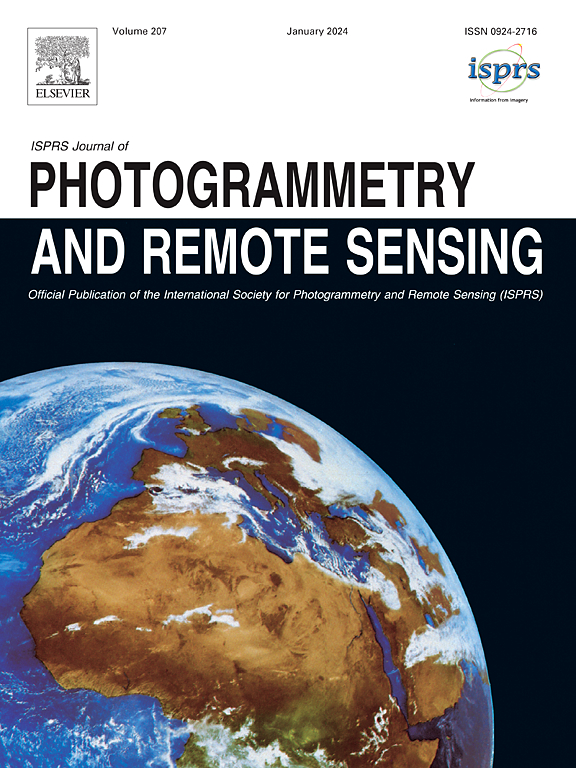利用结合遥感和现场观测的深林重建全球海洋的高分辨率次表层温度
IF 10.6
1区 地球科学
Q1 GEOGRAPHY, PHYSICAL
ISPRS Journal of Photogrammetry and Remote Sensing
Pub Date : 2024-09-25
DOI:10.1016/j.isprsjprs.2024.09.022
引用次数: 0
摘要
估算高分辨率海洋次表层温度对精细研究海洋气候多变性和变化具有重要意义。然而,由于次表层温度数据的分辨率和精度不足,极大地限制了我们对中尺度和其他精细尺度海洋过程的全面了解。在这项研究中,我们整合了多种遥感数据和现场观测数据,在两个框架(梯度提升和深度学习)内对四个模型进行了比较。我们选择了最优模型 "深林 "来生成 1993 年至 2023 年 2000 米上层的高分辨率次表层温度数据集(DORS0.25°)。DORS0.25° 的重建精度非常高,平均 R2 为 0.980,RMSE 为 0.579°C,月平均精度高于 IAP 和 ORAS5 数据集。特别是,DORS0.25°能有效捕捉湾流和黑潮延伸等复杂动态区域的详细海洋变暖特征,有助于研究全球尺度海洋的中尺度过程和变暖。此外,研究还强调,过去十年的变暖速度非常显著,自 2019 年以来,海洋变暖持续创下新高。这项研究表明,DORS0.25°是了解和监测全球海洋变暖时空特征和过程的重要数据集,为海洋环境可持续发展和气候变化行动提供了宝贵的数据支持。本文章由计算机程序翻译,如有差异,请以英文原文为准。
Reconstructing high-resolution subsurface temperature of the global ocean using deep forest with combined remote sensing and in situ observations
Estimating high-resolution ocean subsurface temperature has great importance for the refined study of ocean climate variability and change. However, the insufficient resolution and accuracy of subsurface temperature data greatly limits our comprehensive understanding of mesoscale and other fine-scale ocean processes. In this study, we integrated multiple remote sensing data and in situ observations to compare four models within two frameworks (gradient boosting and deep learning). The optimal model, Deep Forest, was selected to generate a high-resolution subsurface temperature dataset (DORS0.25°) for the upper 2000 m from 1993 to 2023. DORS0.25° exhibits excellent reconstruction accuracy, with an average R2 of 0.980 and RMSE of 0.579 °C, and the monthly average accuracy is higher than IAP and ORAS5 datasets. Particularly, DORS0.25° can effectively capture detailed ocean warming characteristics in complex dynamic regions such as the Gulf Stream and the Kuroshio Extension, facilitating the study of mesoscale processes and warming within the global-scale ocean. Moreover, the research highlights that the rate of warming over the past decade has been significant, and ocean warming has consistently reached new highs since 2019. This study has demonstrated that DORS0.25° is a crucial dataset for understanding and monitoring the spatiotemporal characteristics and processes of global ocean warming, providing valuable data support for the sustainable development of the marine environment and climate change actions.
求助全文
通过发布文献求助,成功后即可免费获取论文全文。
去求助
来源期刊

ISPRS Journal of Photogrammetry and Remote Sensing
工程技术-成像科学与照相技术
CiteScore
21.00
自引率
6.30%
发文量
273
审稿时长
40 days
期刊介绍:
The ISPRS Journal of Photogrammetry and Remote Sensing (P&RS) serves as the official journal of the International Society for Photogrammetry and Remote Sensing (ISPRS). It acts as a platform for scientists and professionals worldwide who are involved in various disciplines that utilize photogrammetry, remote sensing, spatial information systems, computer vision, and related fields. The journal aims to facilitate communication and dissemination of advancements in these disciplines, while also acting as a comprehensive source of reference and archive.
P&RS endeavors to publish high-quality, peer-reviewed research papers that are preferably original and have not been published before. These papers can cover scientific/research, technological development, or application/practical aspects. Additionally, the journal welcomes papers that are based on presentations from ISPRS meetings, as long as they are considered significant contributions to the aforementioned fields.
In particular, P&RS encourages the submission of papers that are of broad scientific interest, showcase innovative applications (especially in emerging fields), have an interdisciplinary focus, discuss topics that have received limited attention in P&RS or related journals, or explore new directions in scientific or professional realms. It is preferred that theoretical papers include practical applications, while papers focusing on systems and applications should include a theoretical background.
 求助内容:
求助内容: 应助结果提醒方式:
应助结果提醒方式:


